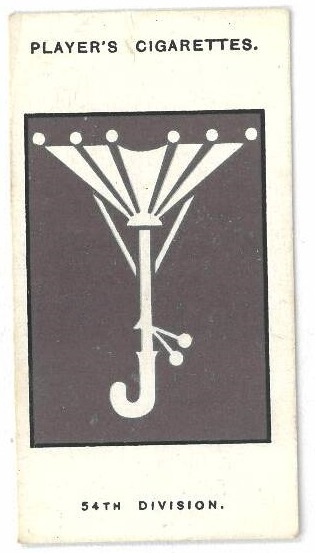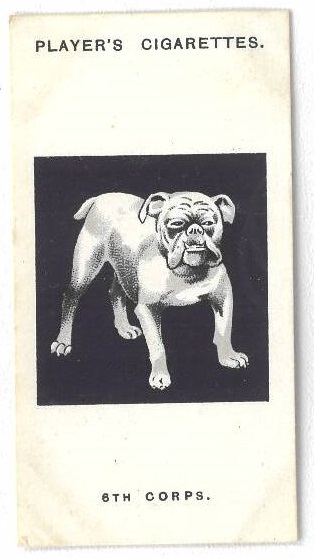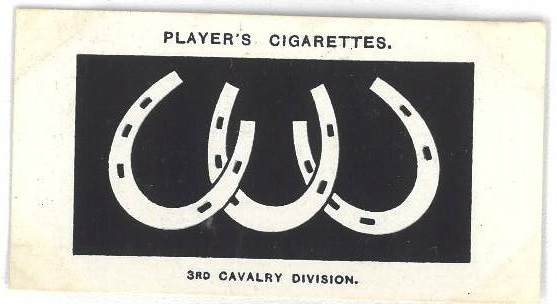No 91- 65th Lowland Division
This, the 2nd Lowland Territorial Division, was formed in September 1914. It remained at home throughout its existence, and was eventually broken up in January 1918. The G.O.C. adopted the sign of the Zodiac for Leo, chiefly on account of its simplicity.
No 92- 1st Corps
This sign was also seen in white on the first quarter of the Corps flag (red, with a white cross). Commanded in the first instance by Lieut-General Sir Douglas Haig, it was part of the original British Expeditionary Force on the Western Front and was composed- in those days- of the 1st and 2nd Divisions. At the time of the Armistice it was under the command of Lieut. General Sir A Holland, and consisted of three divisions- 15th, 16th and 58th. Another of its commanders was Lieut General Sir T.C.. McM. Kayanagh, who afterwards commanded the Cavalry Corps.
No 93- 20th Corps
This rather elaborate design of the pyramid and scarab is copied from the sign recorded in the Imperial War Museum. The Corps was organised in Palestine in August 1917, and took part in the advance through Philistia. It fought at Beersheeba, and at Khuweilfeh, Sheria and Harerira. It captured Jerusalem on December 9th 1917 and Jericho on February 21st, 1918. Later a portion of it took part in the Amman Es Salt Raids, and eventually drove the enemy over the hills of Mount Ephraim, when he became disorganised. The sign was adopted by Lieut. General Sir Edward Bulfin when he took over the corps in March 1918.
No 94- 54th (East Anglian) Division
This was a pre-war territorial division and was mobilised at the outbreak of war. In August 1915 it went out to the Dardanelles and fought in the Gallipoli campaign; then, in the following December, it was transferred to the Egyptian Expeditionary Force. On landing in Egypt it marched across the desert from the Suez Canal and fought in both battles of Gaza in 1917. “Umbrella Hill”, an elaborately entrenched sand hill about 2,000 yards south of Gaza and one of the “strong points” of the defences of that place was effectually raided by the 162nd Brigade in July 1917, and the Turks were turned out. Hence the sign- an umbrella turned inside out!
No 95- First Army
The white stripe which was painted on the back of the First Army cars was very distinctive. It had no history. The First and Second Armies were formed on December 26th 1914. On the Western Front until the Armistice some of the First Army honours were- 1915, Aubers Ridge, Neuve Chapelle, Festubert, Loos (Bois Grenier, Hohenzollern Redoubt); 1916, German Attack on Vimy Ridge, Fromelles; 1917, Arras (Vimy Ridge, Scarpe, La Coulotte, Arleux, Oppy Wood), Lens (Avion, Hill 70); 1918, Somme (Arras), Lys (Estaires, Hazebrouck, Bethhune, La Becque), Hindenburg Line, Pursuit to the Selle, Valenciennes, Sambre (Capture of Mons)
No 96- 6th Corps
The bulldog of the Sixth Corps was on of the best known signs in the whole collection. Lieut. General Sir J.A.L. Haldane took over command of the Corps in 1916, after it was formed, but before it was engaged with the enemy as a Corps. All its service was on the Western Front, where it was heavily involved in the 1917-18 fighting, some of its actions being- 1917, Arras (First, Second and Third Scarpe, Arleux, Roeulx), Cambrai (Bourbon Wood, German Counter Attack); 1918, First Somme (St Quentin, Bapaume, Arras, Ancre), Second Somme (Albert, Bapaume), Hindenburg Line (Havrincourt, Epehy, Canal du Nord, Cambrai), the Selle, and the Sambre.
No 97- 62nd (West Riding) Division
The pelican illustrated was copied from a transport wagon sign and has no particular origin. Sir Walter Braithwaite, who took the Division overseas, originated the “Duck” as it was generally nicknamed. A Second Line Territorial Division, the 62nd went to France in January 1917, and all its service was on the Western Front. Its many honours include- 1917, Ancre, Hindenburg Line, Bullecourt, Lagnicourt, Cambrai; 1918, Somme (Bapaume, Arras), Marne, Second Somme (Bapaume), Hindenburg Line, the Selle, and the Sambre.
No 98- 13th (Western) Division
The iron horseshoe for luck was the sign of the Thirteenth Division, sometime nicknamed the “Iron” division. Formed of New Army Units, the division embarked for the Dardanelles in June 1915. It fought there up to the evacuation, and thence was shipped to Egypt. The following March saw it join the Mesopotamian Expeditionary Force, where (under Major-General Sir W de S. Cayley) it served in the Third Indian Army Corps up to the end. It was the only British Division in that force, the others being the 14th (Indian), 15th (Indian), 17th (Indian) and 18th (Indian) Divisions.
No 99- 3rd Cavalry Division
Like that of the Second Cavalry Division, this sign needs no explanation. The division was formed in October 1914, and saw the War through on the Western Front. Some of its actions number among them- 1914, Defence of Antwerp (reached Bruges), Ypres (Langemarck, Gheluvelt, Nonne Bosschen); 1915, Ypres (Frezenburg Ridge), Loos; 1917, Arras (Scarpe); 1918, Somme (St Quentin, Somme Crossings, Avre), Amiens, Hindenburg Line (Cambrai) and the Pursuit to the Selle.
No 100- 35th Division
The motif of this sign was “seven fives make thirty-five”…On the Western Front for the whole of its fighting service, a few of its engagements were- Somme 1916, Hindenburg Line 1917, Ypres (Paschendaele) 1917, Somme 1918, Courtrai 1918









